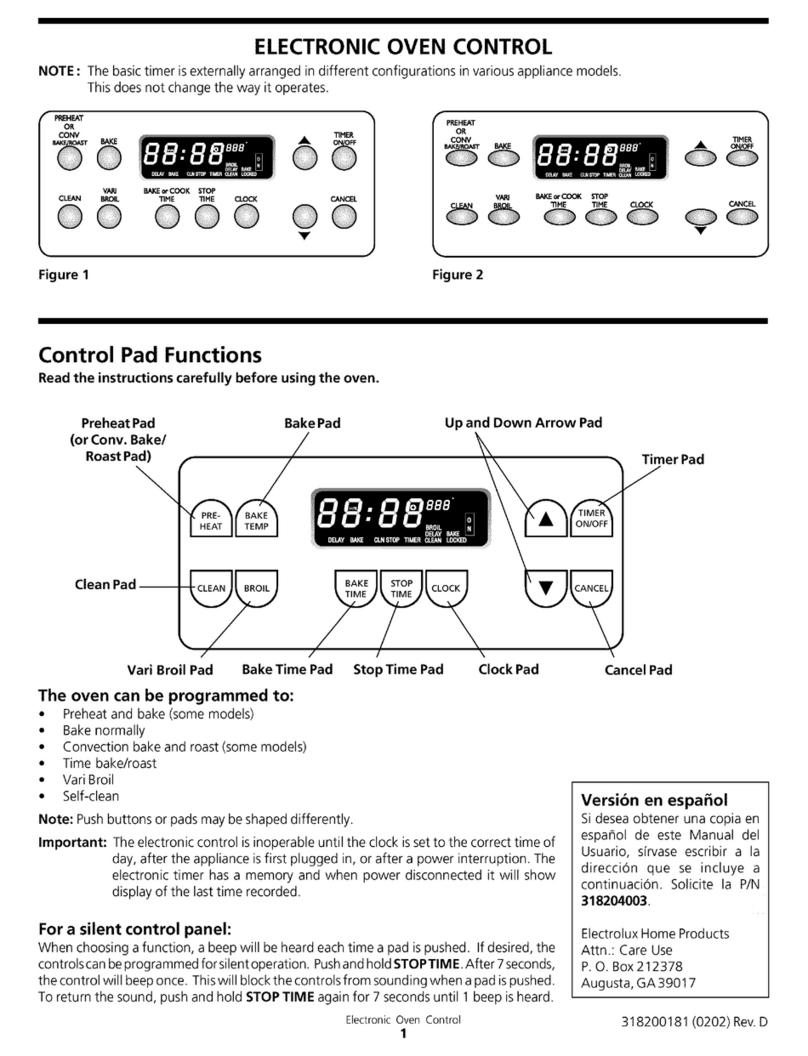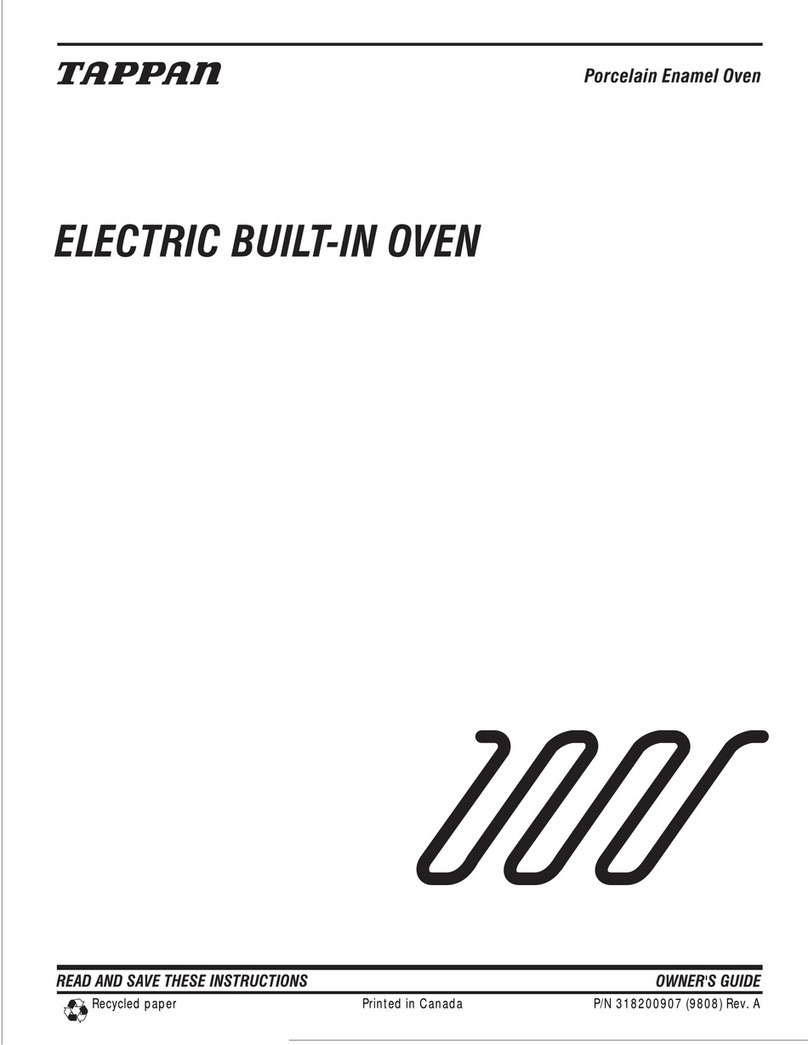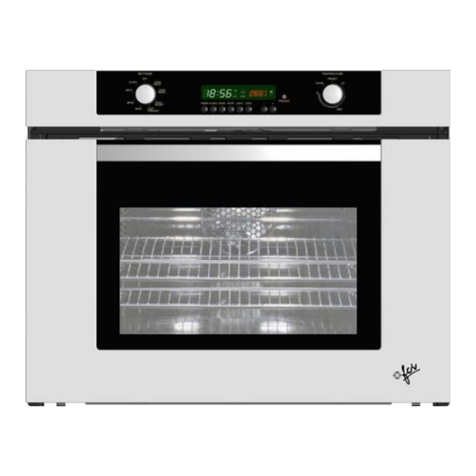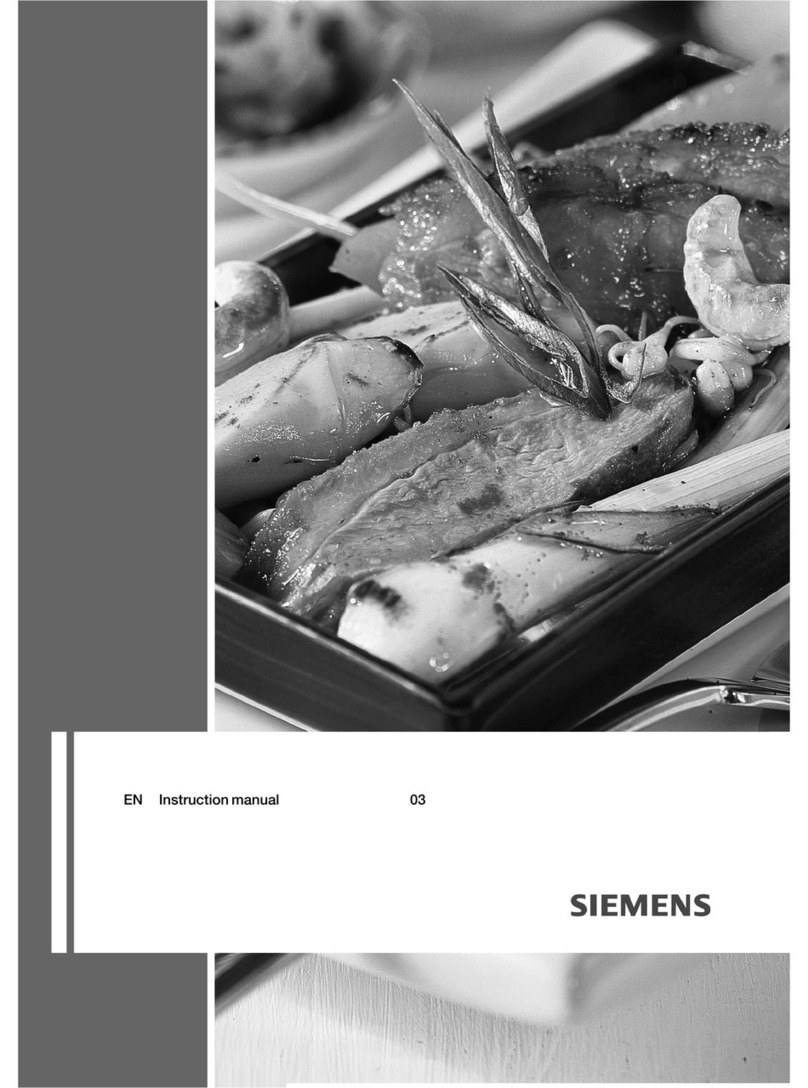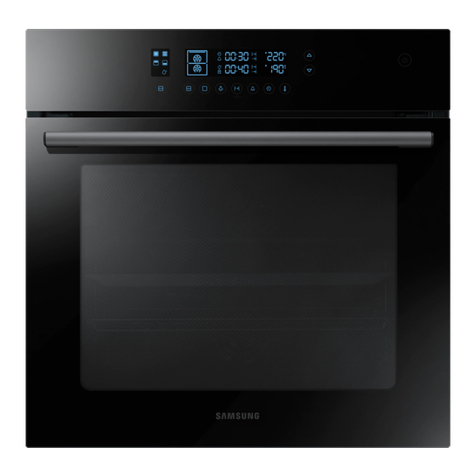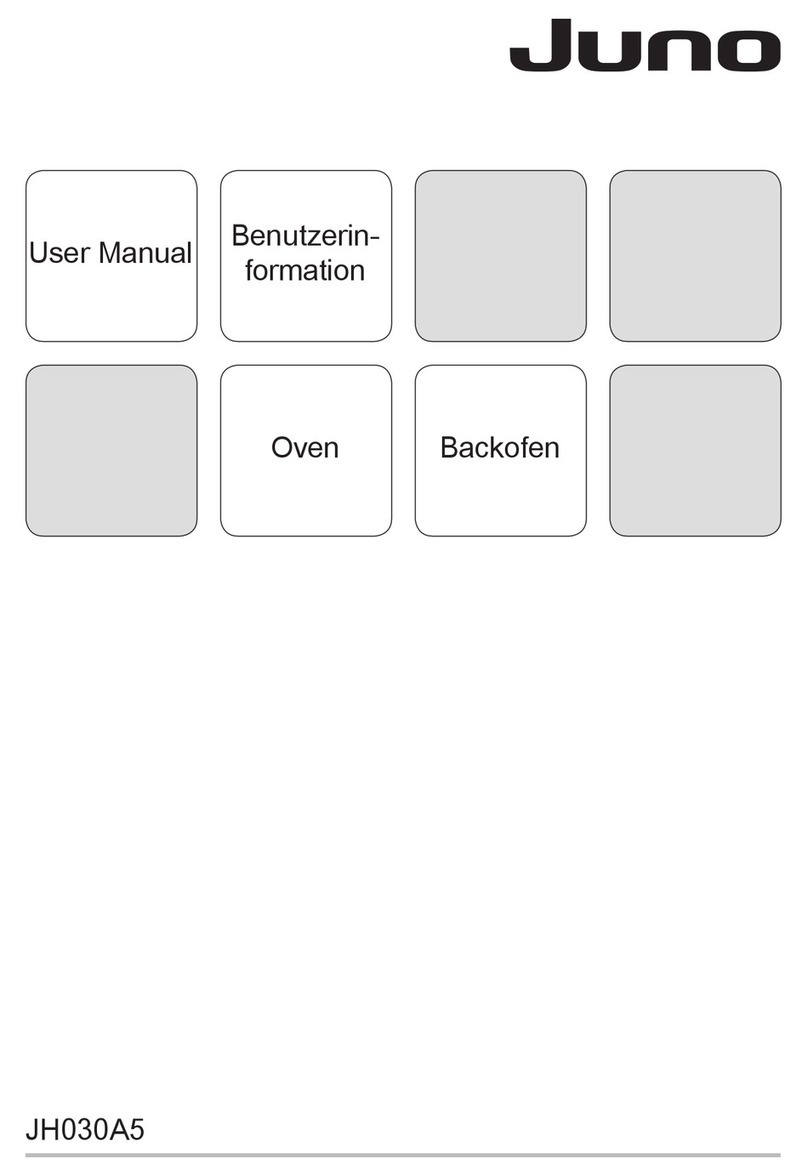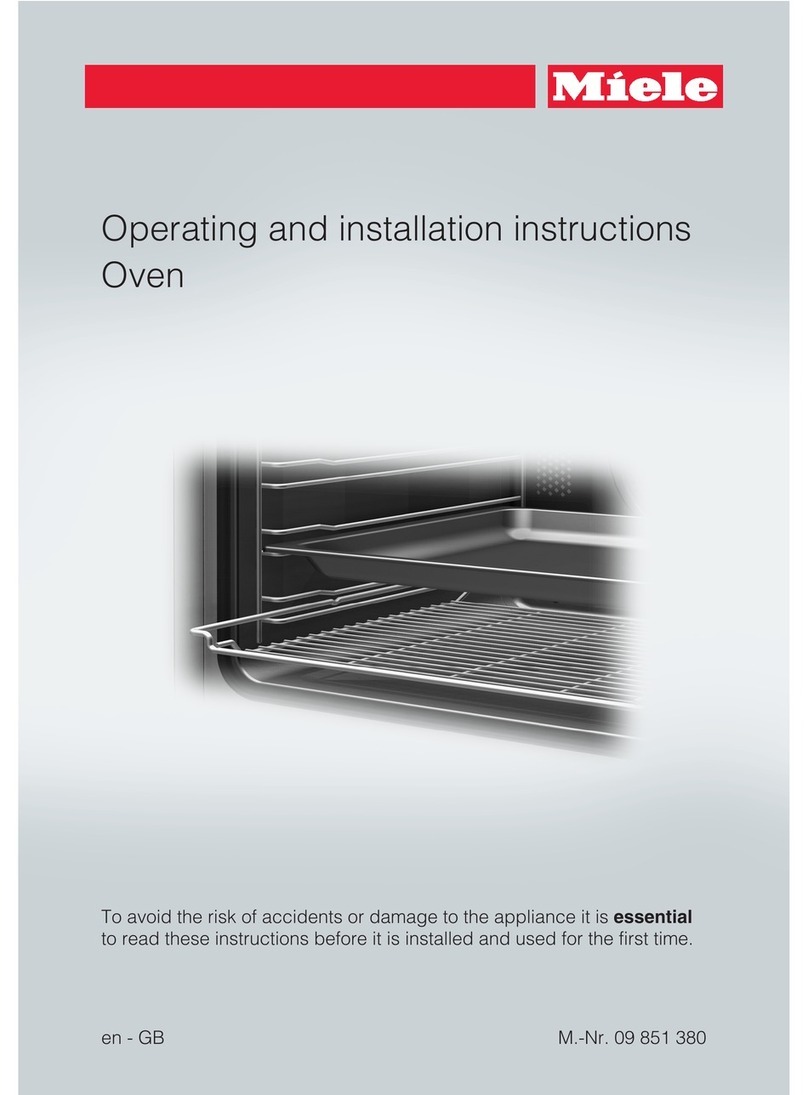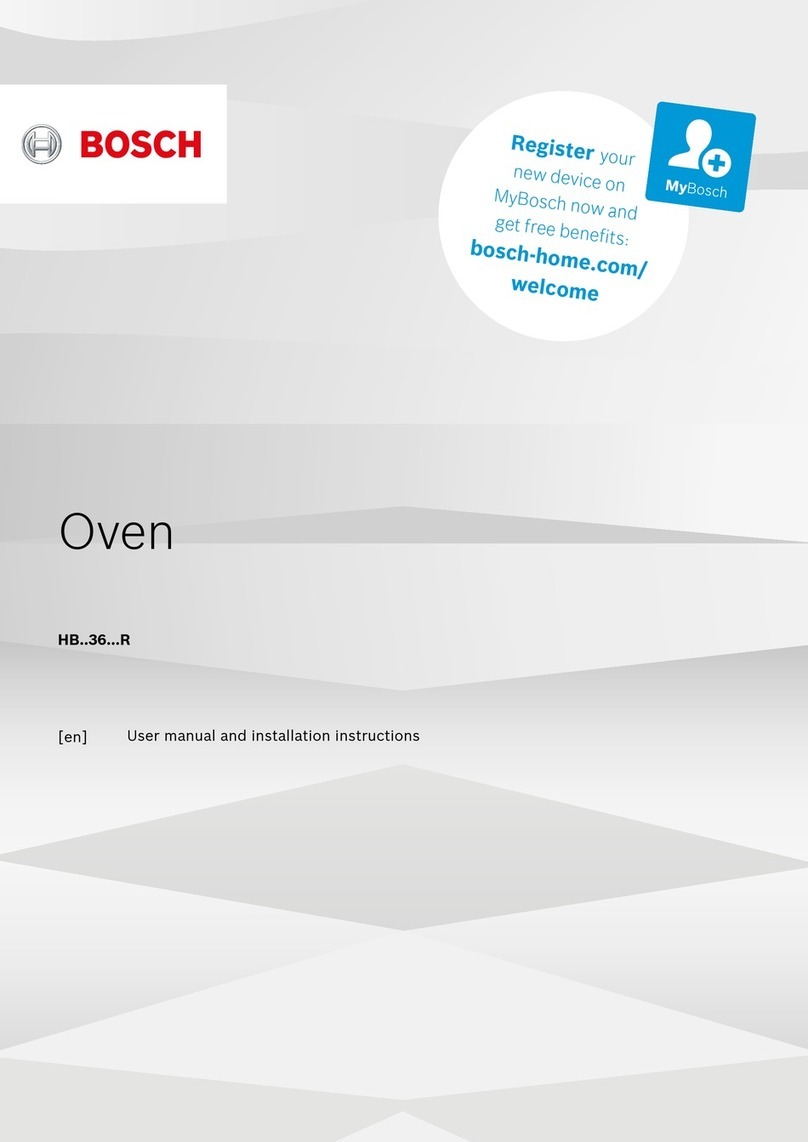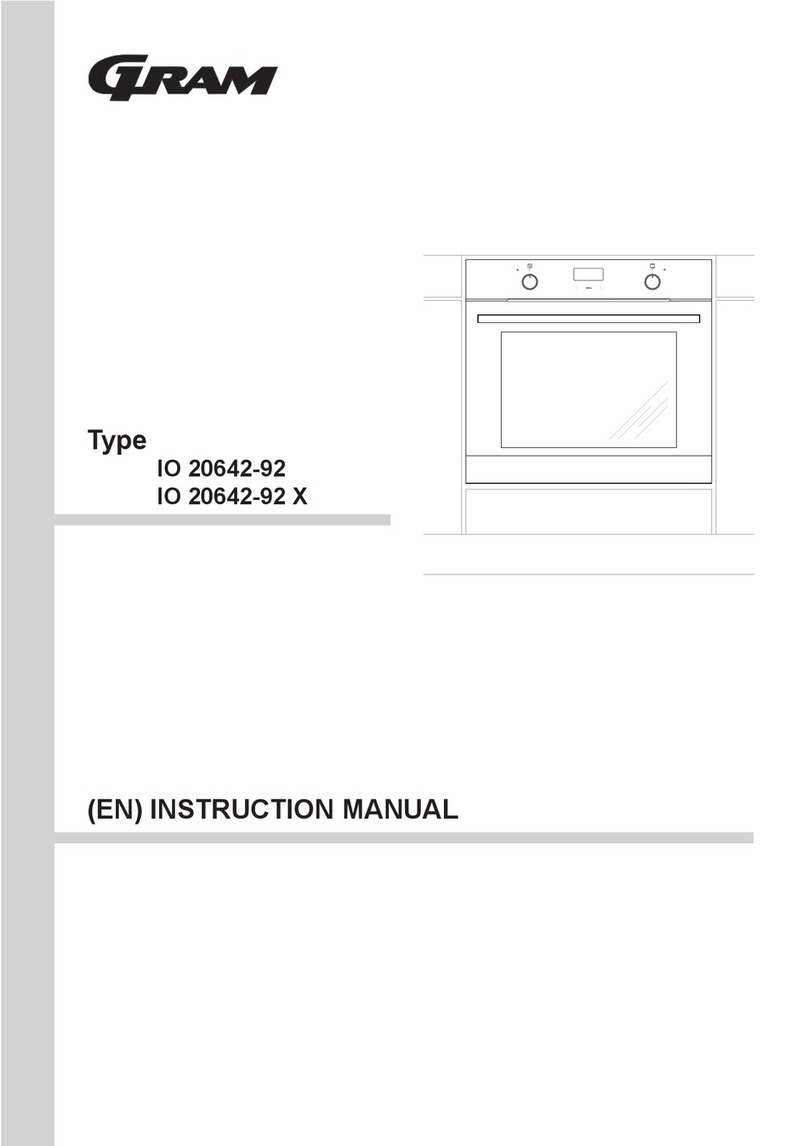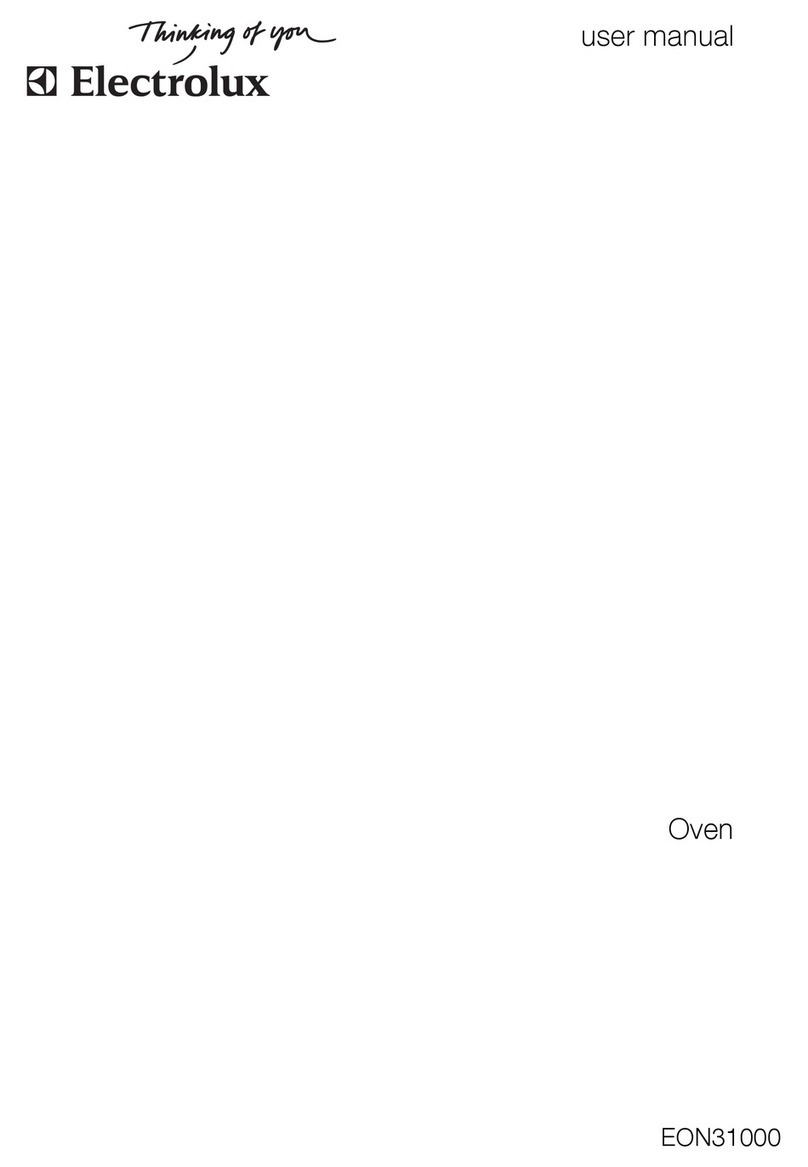Tappan TGB500CGB2 User manual

Printed in Canada P/N 318200950 (9901) Rev. A

2
© 1999 White Consolidated Industries
All rights reserved
Product Registration
Contents 2 ProductRegistration
2 Versión en español
3-4 ImportantSafetyInstructions
4 GroundingInstructions
5 OvenIgnition
5 Liquefied Petroleum (Propane) Gas Conversion
5 BeforeSettingOvenControls
5 SettingOvenControls
5 AdjustingOvenTemperature
6 Oven Baking
6 Air Circulation in the Oven
7-8 Oven Cleaning
8 Setting Conrols for a Clean Cycle
9-11 General Cleaning
11 ChangingOvenLight
12-13 Avoid Service Checklist
14-15 Notes
16 Warranty & Service Information
Register Your Product
ThePRODUCTREGISTRATIONCARD
should be filled in completely, signed
and returned to Frigidaire Company.
Thank you for choosing this appliance. The information contained within this
Owner's Guide will instruct you on how to properly operate and care for your
appliance.Pleaseread throughtheinformation containedinyour literaturepackto
learn more about your new appliance.
Record Your Model and Serial Numbers
Recordinthespaceprovidedbelowthemodelandserialnumbersfoundontheserial
plate located on the lower left hand inner trim of the oven.
ModelNumber:
SerialNumber:
DateofPurchase:
If the information in this manual is not
followed exactly, a fire or explosion may result causing
property damage, personal injury or death.
FOR YOUR SAFETY:
— Do not store or use gasoline or other flammable vapors
and liquids in the vicinity of this or any other appliance.
— WHAT TO DO IF YOU SMELL GAS:
• Do not try to light any appliance.
• Donottouchanyelectricalswitch;donotuseanyphone
in your building.
• Immediately call your gas supplier from a neighbor's
phone. Follow the gas supplier's instructions.
• If you cannot reach your gas supplier, call the fire
department.
— Installationandservicemustbeperformedbyaqualified
installer, servicer or the gas supplier.
This Owner's Guide contains general
operating instructions for your appliance
and feature information for several
models.Yourappliancemaynothaveall
thedescribed features.
Versión en español
Sideseaobtenerunacopiaenespañolde
esteManualdelUsuario,sírvaseescribira
ladirecciónqueseincluyeacontinuación.
Solicite la P/N 318201130.
SpanishOwner'sGuides
FrigidaireCompany
P. O. Box 9061
Dublin,Ohio 43017-0961

3
Donotstoreitemsofinteresttochildreninthe
cabinetsaboveanappliance.Childrenclimbingontheappliance
to reach items could be seriously injured.
• Do not leave children alone—Children should not be left
aloneorunattendedintheareawhereanapplianceisinuse.
They should never be allowed to sit or stand on any part of the
appliance.
• DO NOT TOUCH INTERIOR OVEN BURNERS OR INTERIOR
SURFACESOFTHEWALLOVENUNTILTHEYHAVECOOLED.
The oven heating burners may be hot even though the flames
are not visible. Areas near the burners may become hot enough
tocauseburns.Duringandafteruse,donottouch,orletclothing
or other flammable materials touch these areas until they have
hadsufficienttimetocool. Amongtheseareasaretheovenvent
openings, the surfaces near these openings, oven door and
window.
• Wear Proper Apparel—Loose-fitting or hanging garments
shouldnever beworn whileusing theappliance. Donotlet
clothing or other flammable materials contact hot surfaces.
Never use your appliance for warming or
heating the room.
• Do Not Use Water or Flour on Grease Fires—Smother the
fire with a pan lid, or use baking soda, a dry chemical or
foam-type extinguisher.
•When heating fat or grease, watch it closely. Fat or grease
may catch fire if allowed to become too hot.
•UseOnlyDryPotholders—Moistordamppotholdersonhot
surfaces may result in burns from steam. Do not let the
potholders touch the flame or burners. Do not use a towel or
other bulky cloth instead of a potholder.
•Do Not Heat Unopened Food Containers—Build-up of
pressure may cause the container to burst and result in
injury.
• IMPORTANT—Do not attempt to operate the oven during
apowerfailure.Ifthepowerfails,alwaysturntheovenoff.
Iftheovenisnotturnedoffandthepowerresumes,theovenwill
begin to operate again. Food left unattended could catch fire or
spoil.
•Remove all tape and packaging wrap before using the
appliance. Destroy the carton and plastic bags after
unpacking the appliance. Never allow children to play with
packaging material. Do not remove the wiring label and other
literature attached to the back of the appliance. Do not remove
model/serial number plate.
•Proper Installation—Be sure your appliance is properly
installedandgroundedbyaqualifiedelectricianorinstaller
inaccordance with the National ElectricalCode ANSI/NFPA
No.70(U.S.A.)—latesteditionandlocalcoderequirements.
Install only per installation instructions provided in the literature
package for this appliance.
Askyour dealer to recommend a qualified installer, technician or
an authorized repair service. Know how to disconnect the
electricalpowertotheapplianceatthecircuitbreakerorfusebox
in case of an emergency.
Electronic controllers can be damaged by cold
temperature. When you use your appliance for the first time, or if
ithasnot been used for a long period of time, make sure that it has
beenexposed to a temperature above 0°C/32°F for atleast3hours
before connecting it to the power supply.
•User Servicing—Do not repair or replace any part of the
applianceunlessspecificallyrecommendedinthemanuals.
All other servicing should be done only by a qualified technician.
This may reduce the risk of personal injury and damage to the
appliance.
•Never modify or alter the construction of the appliance by
removing panels, wire covers, or any other part of the
product.
• Removetheovendoorfromanyunused appliance if it is to
be stored or discarded.
Stepping, leaning or sitting on the door or
drawer (if equipped) of this appliance can result in serious
injuries and may also cause damage to the appliance. Do not
allow children to climb or play around the appliance.
• Storage in or on Appliance—Flammable materials should
notbestoredinanovenorinthedrawer(ifequipped).This
includes paper, plastic and cloth items, such as cookbooks,
plasticwareandtowels,aswellasflammableliquids. Donotstore
explosives, such as aerosol cans, in or near the appliance.
Flammable materials may explode and result in fire or property
damage.
Do not use the wall oven for storage.
IMPORTANT SAFETY INSTRUCTIONS
This guide contains important safety symbols and instructions. Please pay special attention to these symbols and follow all instructions given.
Here is a brief explanation of these symbols.
This symbol will help alert you to situations that may cause serious bodily harm, death or property damage.
This symbol will help alert you to situations that may cause bodily injury or property damage.
Read all instructions before using this appliance.
Save these instructions for future reference.

4
IMPORTANT INSTRUCTIONS FOR
USING YOUR OVEN
• UseCareWhenOpeninganOvenDoor—Standtothesideof
the appliance when opening the door of a hot oven. Let hot air
orsteam escape before you remove or replace food in the oven.
• KeepOvenVentDuctsUnobstructed.Thewallovenisvented
at the upper control panel grille or trim or at the center trim
depending of the model. Touching the surfaces in this area
when the wall oven is operating may cause severe burns. Also,
do not place plastic or heat-sensitive items near the oven vent.
These items could melt or ignite.
•Placement of Oven Racks. Always place oven racks in desired
location while oven is cool. If the rack must be moved while the
oven is hot, use extreme caution. Use potholders and grasp the
rack with both hands to reposition. Do not let potholders
contact the oven burner flame or interior of the oven. Remove
all utensils from the rack before removing the rack.
•Donotusethebroilerpanwithoutitsinsert.Thebroilerpan
and grid allow dripping fat to drain and be kept away from the
high heat of the broiler.
•Donotcoverthebroilergridorovenbottomwithaluminum
foil. Exposed fat and grease could ignite.
•Donottouchahotovenlightbulbwithadampcloth.Doing
so could cause the bulb to break. Disconnect the oven or shut
off the power to the oven before removing and replacing the
bulb.
IMPORTANT INSTRUCTIONS FOR
CLEANING YOUR OVEN
• Cleantheapplianceregularlytokeepallpartsfreeofgrease
that could catch fire. Do not allow grease to accumulate.
• KitchenCleaners/Aerosols—Alwaysfollowthemanufacturer's
recommended directions for use. Be aware that excess residue
from cleaners and aerosols may ignite causing damage and/or
injury.
SELF-CLEANING OVENS:
• Clean in the self-cleaning cycle only the parts of the oven
listed in this owner's guide. Before self-cleaning the oven,
remove the broiler pan and any utensils stored in the oven.
• Donotcleantheovendoorgasket.Thedoorgasketisessential
foragoodseal.Careshouldbetakennottorub,damageormove
the gasket.
• Do not use oven cleaners. No oven cleaner or oven liner
protective coating of any kind should be used in or around any
part of the oven.
SAVE THESE INSTRUCTIONS
IMPORTANT SAFETY INSTRUCTIONS(continued)
GroundingInstructions
IMPORTANT: READ AND SAVE THESE INSTRUCTIONS.
This appliance is equipped with a 3-prong grounding plug for your
protectionagainst shockhazard and shouldbe plugged directlyinto aproperlygrounded
receptacle. DO NOT cut or remove the grounding prong from this plug.
Forpersonalsafety,thisovenmustbeproperlygrounded. Formaximumsafety,thepower
cord must be plugged into a 120V—60 Hz. outlet that is correctly polarized and properly
grounded.
If a 2-prong wall receptacle is the only available outlet, it is the personal responsibility
of the consumer to have it replaced with a properly grounded 3-prong wall receptacle
installed by a qualified electrician.
DONOTUNDERANYCIRCUMSTANCESCUTORREMOVETHETHIRDROUNDGROUNDING
PRONGFROMTHEPOWERCORDPLUG.SEETHEINSTALLATIONINSTRUCTIONSPACKAGED
WITH THIS OVEN FOR COMPLETE INSTALLATION AND GROUNDING INSTRUCTIONS. DO
NOT OPERATE THE OVEN USING A TWO-PRONG ADAPTER OR AN EXTENSION CORD.
Avoidfirehazardorelectrical
shock. Do not use an adaptor plug, an
extension cord, or remove grounding prong
from electrical power cord. Failure to follow
this warning can cause serious injury, fire or
death.

5
Oven Ignition
When you turn the oven on, the glow bar igniter begins to heat. When the lighter is hot enough, in less than 1 minute, the gas flows into
the burner and is ignited.
The igniter glows bright orange when hot. It cycles on and off with the thermostat and will glow whenever the burner is on.
Donotattempttolighttheovenburnersduringapowerfailure.Theovenburnervalveswillnotopenupandwillprevent
the gas from flowing through the burner valves to the burners. In the event of a power failure, turn Temperature Control knob OFF. When
power resumes, turn the Temperature Control knob back to desired temperature.
Liquefied Petroleum (Propane) Gas Conversion
This appliance can be used with Natural Gas or Liquefied Petroleum (Propane) Gas. It is shipped from the factory for use with Natural
Gas.
Refer to the Installation Instructions for conversion from Natural Gas to Propane Gas, or from Propane Gas to Natural Gas.
Severe shock or damage to the appliance may occur if the appliance is not installed by a qualified installer.
Before Setting Oven Controls
Oven Vent Location
The oven is vented through the upper control panel trim or through the center trim, between the control panel and the oven door
depending of the model. A vent deflector moves heated air away from the unit for upper trim vented units. When the oven is on, warm air
is released through the vent. This venting is necessary for proper burner operation in the oven and good baking results. DO NOT block
the vent. Doing so may cause baking failures, fire or damage to the wall oven.
Arranging Oven Racks
ALWAYSARRANGEOVENRACKSWHENTHEOVENISCOOL(PRIORTO OPERATINGTHEOVEN).Always
use oven mitts when using the oven.
To remove an oven rack, pull the rack forward until it stops. Lift up front of rack and slide out.
Toreplace anoven rack,fitthe rackonto theguides onthe ovenwalls.Tiltthefrontofthe rackupward
and slide the rack back into place.
Setting Oven Controls
For setting oven controls, refer to the Timer Section or Electronic Oven Control Guide.
Adjusting Oven Temperature
For instruction on how to adjust the oven temperature refer to the Timer Section or Electronic Oven Control Guide.

6
Corrections
• Allow oven to preheat to the selected temperature before placing
food in oven.
• Choose pan sizes that will permit 2-4" (5-10 cm) of air space on all
sides when placed in the oven.
• Use a medium-weight aluminum baking sheet.
• Allow oven to preheat to the selected temperature before placing
food in the oven.
• Use proper rack position for baking needs.
• Set oven temperature 25°F/12°C lower than recommended.
• Set oven temperature 25°F/12°C lower than recommended.
• Use pan size suggested in recipe.
• Use proper rack position and place pan so there is 2-4" (5-10 cm)
of space on all sides of pan.
• Place a marked glass measuring cup filled with some water on the
center of the oven rack. If the water level is uneven, refer to the
installation instructions for leveling the range.
• Besuretoallow2-4"(5-10cm)ofclearanceonallsidesofeachpan
in the oven.
• Do not use pans that are dented or warped.
• Check oven rack for flatness and proper positioning.
• Set oven temperature 25°F/12°C higher than suggested and bake
for the recommended time.
• Besuretoremoveallpansfromtheovenexcepttheonestobeused
for baking.
• Open oven door only after shortest recommended baking time.
Oven Baking
"Baking" means to cook foods such as cakes or casseroles by dry heat in a covered or uncovered pan. Roasting, often confused with baking,
means to cook meat in an uncovered pan. To Bake or Roast, follow the instructions in the Setting Oven Controls section.
Product Expectations
The cooking times and temperatures needed to bake a product may vary slightly from your
previously owned appliance
Baking Problems
Cookies and biscuits
burn on the bottom.
Cakestoodarkontop
or bottom.
Cakesnot done inthe
center.
Cakes not level.
Foodsnotdonewhen
cookingtime is up.
Causes
• Cookies and biscuits put into the oven
before the preheating time(10 minutes
approx.) is completed.
• Oven rack overcrowded.
• Dark pan absorbs heat too fast.
• Cakes put into the oven before pre-
heating time(10 minutes approx.) is
completed.
• Rack position too high or low.
• Oven too hot.
• Oven too hot.
• Incorrect pan size.
• Pan not centered in oven.
• Range not level.
• Pan too close to oven wall or rack
overcrowded.
• Pan warped.
• Oven rack not level.
• Oven too cool.
• Oven overcrowded.
• Oven door opened too frequently.
Air Circulation in the Oven
Forbest air circulation and bakingresults,center pans as much as possible.Allow2-4" (5-10 cm) around the utensil(s)for proper air circulation
and be sure pans do not touch each other, the door, sides or back of oven. The hot air must circulate around the pans in the oven for even
heat to reach all parts of the oven.
If using multiple pans, stagger as shown. If using one pan, place in center of oven.
Baking Problems and
Solutions Chart (Below)

7
Oven Cleaning
Non Self-Clean Oven(Some Models)
Porcelain has a smooth finish and is a type of glass fused to metal. Oven cleaners can be used on all interior surfaces.
REMOVE SPILLOVERS AND HEAVY SOILING AS SOON AS POSSIBLE. REGULAR CLEANINGS WILL REDUCE THE NUMBER OF MAJOR
CLEANINGS LATER.
Adhereto thefollowing cleaningprecautions:
• Allow the oven to cool before cleaning.
• Wear rubber gloves when cleaning the oven manually.
General Cleaning
Remove soils using hot, soapy water. Do not allow food spills with a high sugar or acid content (such as milk, tomatoes, sauerkraut, fruit
juices or pie filling) to remain on the surface as they may cause a dull spot even after cleaning.
To Remove Heavy Soil
1. Allow a dish of ammonia to sit in the oven overnight or for several hours with the oven door closed. Clean softened spots using hot,
soapy water. Rinse well with water and a clean cloth.
2. If soil remains, use a soap-filled scouring pad or a nonabrasive cleaner. If necessary, use an oven cleaner following manufacturer's
instructions. DO NOT mix ammonia with other cleaners.
3. Clean any soil from the oven frame, the door liner outside the oven door gasket, the small area at the front center of the oven bottom
and the oven vent exit (located below the backguard or at the lower end of the upper control panel). Clean with hot, soapy water.
Rinse well using clean water and a cloth.
Adhere to the following precautions when using oven cleaners:
1. DO NOT spray on the electrical controls or switches because it could cause a short circuit and result in sparking or fire.
2. DO NOT allow a film from the cleaner to build up on the temperature sensing bulb; it could cause the oven to heat improperly. (The
bulb is located in the rear of the oven). Carefully wipe the bulb clean after each oven cleaning, being careful not to move the bulb. A
change in its position cold affect how the oven bakes. Avoid bending the bulb and capillary tube.
3. DO NOT spray any cleaner on the oven door trim and gasket, handles or any exterior surfaces of the appliance, wood or painted
surfaces. The cleaner can damage these surfaces.
Ammonia must be rinsed before operating the oven. Provide adequate ventilation.
DO NOT line the oven walls, bottom, racks or any other part of the appliance with aluminum foil. Doing so will destroy
heat distribution, produce poor baking results and cause permanent damage to the oven interior (aluminum foil will melt to the interior
surface of the oven)
Cleaning the Oven Bottom (some models)
The oven bottom in non self-clean oven models can be removed for cleaning. See "To Remove and Replace Oven Bottom" under
GeneralCleaning.
Clean using hot, soapy water, a mild abrasive cleanser, a soap-filled abrasive pad or oven cleaner following manufacturer's instructions.

8
Oven Cleaning (continued)
Cleaning the self-Clean Oven(some models)
Adhere to the following cleaning precautions
• Allow the oven to cool before cleaning.
• Wear rubber gloves when cleaning any exterior parts of the oven manually.
Duringtheself-cleaningcycle,theoutsideoftheovencanbecomeveryhottotouch.DONOTleavesmallchildrenunattended
near the appliance.
Before cleaning any part of the oven, be sure the electronic oven control is turned off or else push CANCEL pad. Wait until the oven is cool.
DO NOT use commercial oven cleaners or oven protective coatings in or around any part of the self-cleaning oven. DO NOT clean the oven
door gasket. The gasket on the oven door is essential for a good seal. Care should be taken not to rub, damage or move the gasket. DO NOT
useanycleaningmaterialsonthegasket.Doingsocoulddamageit.DONOTusealuminumfoiltolinetheovenbottom.Thismayaffectcooking
or foil could melt and damage the oven surface.
A self-cleaning oven cleans itself with high temperatures (well above cooking temperatures) which eliminate soil completely or reduce it to
a fine powdered ash you can whisk away with a damp cloth.
PREPARING THE OVEN FOR SELF-CLEANING
1. Remove any excess spillovers in the oven cavity before starting the self-cleaning cycle. To clean, use hot soapy water and a cloth. Large
spillovers can cause heavy smoke or fire when subjected to high temperatures. DO NOT allow food spills with a high sugar or acid content
(such as tomatoes, sauerkraut, fruit juices or pie filling) to remain on the surface as they may cause a dull pot even after cleaning.
2. Clean any soil from the oven frame ant the door liner. These areas heat sufficiently during a self-clean cycle to burn soil on. Clean with
soap and water.
3. Remove the broiler pan and insert, all utensils and any foil. These items do not withstand high cleaning temperatures.
4. Oven racks may be left in the oven or may be removed. If they go through the clean cycle, their color will turn slightly dull. After the cycle
is completed and the oven has cooled, rub the sides of the racks with wax paper or a cloth containing a small amount of a baby oil or salad
oil. This will make racks glide easier.
WHAT TO EXPECT DURING CLEANING
While the oven is in operation, the oven heats to temperatures much higher than those used in normal cooking. Sounds or metal expansion
and contraction are normal. Odor is also normal as the food soil is being removed. Smoke may appear through the oven vent.
If heavy spillovers are not wiped up before cleaning, they may flame and cause more smoke and odor than usual. This is normal and safe and
should not cause alarm. If available, use an exhaust fan during the self-cleaning cycle.
Setting the Controls for a Clean Cycle
For setting the clean cycle, refer to the timer Section or Electronic Oven Control Guide.

9
Surfaces
Aluminum (Trim Pieces)
Glass, Painted and Plastic
Body Parts and Decorative Trim
ControlPanel
Porcelain Enamel
Broiler Pan and Grid, Door Liner,
Oven Bottom
Oven and Broiler Rack(s)
Oven Door
How to Clean
Usehot,soapywaterandacloth.Drywithacleancloth.DONOTscouroruseall-purposecleaners,
ammonia, powdered cleansers or commercial oven cleaner. They can scratch and discolor
aluminum.
Forgeneralcleaning,usehotsoapy waterandacloth.Formore difficultsoilsandbuilt-upgrease,
apply a liquid detergent directly onto the soil. Leave on soil for 30 to 60 minutes. Rinse with a
damp cloth and dry. DO NOT use abrasive cleaners, spray cleaners or scouring pads on any of
these materials. These cleaners can permanently damage the control pad surface.
Before cleaning the control panel, turn all controls to OFF and remove the control knobs. To
remove,pulleachknobstraightoffthesaft.Cleanasinstructedabove.Squeezeexcesswaterfrom
the cloth before wiping the panel; especially when wiping around the controls. Excess water in
or aroud the controls may cause damage to the appliance. To replace knobs after cleaning, line
up the flat sides of both the knob and the saft, then push the knob(s) into place.
Gentle scouring with a soapy scouring pad will remove most spots. Rinse with a 1:1 solution of
clearwaterandammonia.Ifnecessary,coverdifficultspotswithanammonia-soakedpapertowel
for 30 to 40 minutes. Rinse with clean water and a damp cloth, and then scrub with a soap-filled
scouring pad. Rinse and wipe dry with a clean cloth. Remove all cleaners or the porcelain may
become damaged during future heating.
For Non Self-Clean Models: Clean by using a mild, abrasive cleaner following manufacturer's
instructions. Rinse with clean water and dry. After cleaning the racks, rub the sides of the racks
with wax paper or a cloth containing a small amount of baby oil or salad oil (this will make the
racks glide easier into the rack position).
For Self-Clean Models: Oven racks may be removed or left in the oven during the self-clean cycle
for cleaning. If removed, follow instructions above.
If the racks are cleaned in the self-clean cycle, their color will turn slightly blue and the finish will
bedull. After the self-cleancycle is completed andtheoven has cooled, rubthesides of the racks
with wax paper or a cloth containing a small amount of baby oil or salad oil (this will make the
racks glide easier into the rack positions).
To clean oven door, wash with hot, soapy water and a clean cloth. DO NOT immerse the door in
water.DONOTcleantheovendoorgasket.Theovendoorgasketismadeofawovenmaterialwhich
is essential for a good seal. Care should be taken not to rub, damage or remove oven door the
gasket.
General Cleaning
Cleaning Various Parts of Your Appliance
Beforecleaninganypartoftheappliance,besureallcontrolsareturnedOFFandtheovenisCOOL.REMOVESPILLOVERSANDHEAVYSOILING
AS SOON AS POSSIBLE. REGULAR CLEANINGS WILL REDUCE THE NUMBER OF MAJOR CLEANING LATER.

10
General Cleaning(continued)
To Remove and Replace Oven Door
1. Open the door to the fully opened posi-
tion.
2. Pull up the lock located on each hinge
supportand engageit inthe hook ofthee
lever.Youmayhavetoapplyalittledown-
ward pressure on the door to pull the
locks fully over the hooks.
3. Grasp the door by the sides, pull the
bottomof the door up and toward you to
disengage the hinge supports.
4. Keep pulling the bottom of the door
toward you while rotating the top of the
door toward the appliance to completely
disengage the hinge levers.
5. Toreinstallthe oven door,reversesteps 1through4. Make surethe hinge supportsarefully engagedbeforeunlocking the hinge levers.
The door is heavy. For safe, temporary storage, lay the door flat with the inside of the door facing down.
To Remove and Replace Oven Bottom
To Remove the Oven Bottom:
1. Lift up the lift tab at the back of the oven bottom
2. Slide oven bottom out, and lift it up and out.
To Replace the Oven Bottom:
1. Slide horizontal tabs on back of oven bottom into the holes at the back of oven cavity.
2. Lower the front of the oven bottom so locking flange fits into locking channel.
3. Replace lift tab to hold oven bottom in place.
Door Removal

11
General Cleaning(continued)
Storage Drawer(self-Clean Models) or Broiler Drawer ( Non Self-Clean Models)
The drawer can be removed to facilitate cleaning under the wall oven. Use care when handling the drawer.
To Remove the Storage or Broiler Drawer
1. Open and empty the drawer of all utensils.
2. Pull drawer out to drawer stop.
3. Tilt the drawer down and pull it out over the rollers. Or, tilt the drawer up and pull it out over
the rollers (larger storage drawer models only).
To Replace the Storage or Broiler Drawer
1. Insert the rear end of the drawer into the opening.
2. Fit the end rollers onto the guide rails.
3. Holdthedrawer ina horizontalposition,then pushin. Or,pushthe drawerin untilit stops,then
lift to allow the rollers to clear the roller guide stop and push in (larger storage drawer models
only).
Flammable materials should not be stored in an oven or in the storage or broiler drawer or compartment (if equipped). This
includes paper, plastic and cloth items, such as cookbooks, plasticware and towels, as well as flammable liquids. Do not store explosives,
such as aerosol cans, on or near the appliance. Flammable materials may explode and result in fire or property damage.
Changing Oven Light
Be sure the oven is unplugged and all parts are COOL before replacing the oven
light. Wear a leather-faced glove for protection against possible broken glass.
Use the rocker or the push button switch on the control panel to turn the oven light on or off.
To Change the Oven Light
1. Turn electrical power off at the main source or unplug the oven.
2. Press wire holder to one side to release the glass shield (some models).
3. Replace bulb with a new 40 watt appliance bulb.
4. Replace glass shield in socket and snap wire holder into place (some models).
5. Turn power back on again at the main source (or plug the oven back in).
6. Theclock(ifequipped)willthenneedtobereset.Toreset,seeSettingtheClockandMinute
Timer in this Owner's Guide.
Storage or Broiler Drawer

12
OCCURRENCE
Oven Control Beeps and Displays
-F1- or -F3-.
Oven is not level.
Entire appliance does not operate.
Oven does not operate.
Oven light does not work.
POSSIBLE CAUSE/SOLUTION
Electronic control has detected a fault condition. Push Cancel to clear the display and stop
the display from beeping. Reprogram the oven. If a fault reoccurs, record the fault number,
push the Cancel button and contact an authorized servicer.
Poor installation. Place a level on an oven rack in center of oven. Contact installing agent if
rack is not level.
Kitchen cabinet misalignment may make oven appear to be unlevel. Be sure cabinets are
square and level. Contact cabinet maker to correct problem.
Make sure cord/plug is securely plugged into electrical outlet.
Cord/plug is not installed or connected. Cord/plug is not supplied with oven. Contact your
dealer, installing agent or authorized servicer.
Service wiring not complete. Contact your dealer, installing agent or authorized servicer.
Power outage. Check house lights to be sure. Contact your local electric company.
Short in cord/plug. Replace cord/plug.
Electronic controls are not set properly. See instructions under Setting Oven Controls in
the Electronic Control Guide or Oven Cleaning.
House fuse has blown or circuit breaker has tripped immediately following installation.
House fuse may not be fully engaged. Check fuse or engage circuit breaker securely.
House fuse has blown or circuit breaker has tripped after the oven has been installed and
previously operating. Call an authorized servicer.
Make sure gas supply shut-off valve is opened before turning on the oven after installing
the wall oven.
Burned out or loose bulb. Follow instructions under Changing Oven Light to replace or
tighten the bulb.
Avoid Service Checklist
Before you call for service, review this list. It may save you time and expense. The list includes common occurrences that are not the result of
defective workmanship or materials in this appliance.
This oven is equipped with an electronic oven controller (some models). Among its many features is a full time oven circuit diagnostics system.
The controller constantly monitors its internal circuitry as well as several crucial oven circuits, to insure they are all operating correctly. If at any
time one of these systems fail, the controller will immediately shut down operation, and will beep and flash an error code of -F1- or -F3- in
the display window.

13
Oven or broiler drawer smokes
excessivelyduringbroiling.
PoorBakingResults.
Self-cleaning cycle does not work.
Soil not completely removed after self-
cleaningcycleiscompleted.
Flames inside oven or smoke from vent.
Oven door is open. Door should be closed during broiling.
Meat too close to the broil burner. Reposition the rack to provide more clearance between
the meat and the broiler.
Meat not properly prepared. Remove excess fat from meat. Slash remaining fatty edges to
prevent curling, but do not cut into the lean.
Grid on broiler pan wrong side up. Grease cannot drain into broiler pan. Always place the
grid on the broiler pan with the ribs up and the slots down to allow grease to drip into the
pan.
Broiler pan used without grid or grid covered with foil. DO NOT use the broiler pan without
the grid or cover the grid with foil.
Greasespattersandfoodbuildupcauseexcessivesmoke.Regularcleaningisnecessarywhen
broiling frequently.
Manyfactorsaffectbakingresults.SeeBakingsectionforhints,causesandcorrections. See
Adjusting Oven Temperature in the Electronic Control Guide Brochure.See Arranging
OvenRacks.
Controls not set properly. Follow instructions under Oven Cleaning.
Self-cleaningcyclewasinterrupted.Stoptimemustbeset2-4hourspastthestarttime.Follow
steps under "To Stop or Interrupt a Self-Cleaning Cycle "in the Oven Cleaning section.
Failuretocleanbottom,fronttopofoven,frameofovenordoorareaoutsideovenseal.These
areas are not in the self-cleaning area, but get hot enough to burn on residue. Clean these
areas before the self-cleaning cycle is started. Burned on residue can be cleaned with a stiff
nylon brush and water or a nylon scrubber. Be careful not to damage the oven gasket.
Excessive spillovers in oven. Set the self-cleaning cycle for a longer cleaning time.
Excessive spillovers in oven. This is normal, especially for high oven temperatures, pie
spillovers or for large amounts of grease on bottom of oven. Wipe up excessive spillovers
before starting the self-cleaning cycle.
Avoid Service Checklist(Continued)

14
Notes

15
Notes

16
TAPPAN,THROUGHITSAUTHORIZED
SERVICERS,WILL:
Pay all costs for repairing or replacing any parts of this
appliance which prove to be defective in materials or
workmanship.
All of the provisions of the full warranty above and the
exclusions listed below apply.
THECONSUMERWILLBE
RESPONSIBLEFOR:
CostsofservicecallsthatarelistedunderNORMAL
RESPONSIBILITIESOFTHECONSUMER.*
Costsofthetechnician'straveltothehomeandany
costs for pick up and delivery of the appliance
required because of service.
FULLONE-YEAR
WARRANTY
LIMITEDWARRANTY
(Applicabletothe
StateofAlaska)
WARRANTY
PERIOD
One year from original
purchasedate.
Timeperiodlistedabove.
This warranty applies only to products in ordinary household use, and the consumer is responsible for the
items listed below:
1. Proper use of the appliance in accordance with instructions provided with the product.
2. Proper installation by an authorized servicer in accordance with instructions provided with the appliance and in
accordance with all local plumbing, electrical and/or gas codes.
3. Proper connection to a grounded power supply of sufficient voltage, replacement of blown fuses, repair of loose
connections or defects in house wiring.
4. Expenses for making the appliance accessible for servicing, such as removal of trim, cupboards, shelves, etc., which
are not a part of the appliance when it was shipped from the factory.
5. Damages to finish after installation.
6. Replacement of light bulbs and/or fluorescent tubes (on models with these features).
This warranty does not cover the following:
1. CONSEQUENTIAL OR INCIDENTAL DAMAGES SUCH AS PROPERTY DAMAGE AND INCIDENTAL EXPENSES RESULTING
FROM ANY BREACH OF THIS WRITTEN OR ANY IMPLIED WARRANTY.
Note: Some states do not allow the exclusion or limitation of incidental or consequential damages, so this limitation
or exclusion may not apply to you.
2. Service calls which do not involve malfunction or defects in workmanship or material, or for appliances not in ordinary
household use. The consumer shall pay for such service calls.
3. Damages caused by services performed by persons other than authorized Tappan servicers; use of parts other than
Frigidaire Home Products Genuine Renewal Parts; obtained from persons other than such servicers; or external causes
such as abuse, misuse, inadequate power supply or acts of God.
4. Products with original serial numbers that have been removed or altered and cannot be readily determined.
Keepyour billofsale, delivery slip,orsome otherappropriatepayment record. The dateonthe billestablishesthe warranty
period should service be required. If service is performed, it is in your best interest to obtain and keep all receipts. This
written warranty gives you specific legal rights. You may also have other rights that vary from state to state. Service under
this warranty must be obtained by following these steps, in order:
1. Contact Frigidaire Home Products Consumer Services or an authorized Tappan servicer.
2. If there is a question as to where to obtain parts or service, call or write our Consumer Relations Department at:
Frigidaire Home Products Consumer Relations
P.O. Box 212378
Augusta, Georgia 30917-2378
(800) 944-9044
Product features or specifications as described or illustrated are subject to change without notice. All warranties are made
by White Consolidated Industries, Inc. This warranty applies only in the 50 states of the U.S.A. and Puerto Rico.
*NORMAL
RESPONSIBILITIES
OF THE CON-
SUMER
EXCLUSIONS
IF YOU NEED
SERVICE
TAPPAN WALL OVEN WARRANTY
Your Tappan product is protected by this warranty
Your appliance is warranted by Frigidaire Home Products, a division of White Consolidated Industries, Inc. We authorize no person to change
or add to any of our obligations under this warranty. Our obligations for service and parts under this warranty must be performed by Frigidaire
Home Products Consumer Services or an authorized Tappan servicer.
Table of contents
Other Tappan Oven manuals
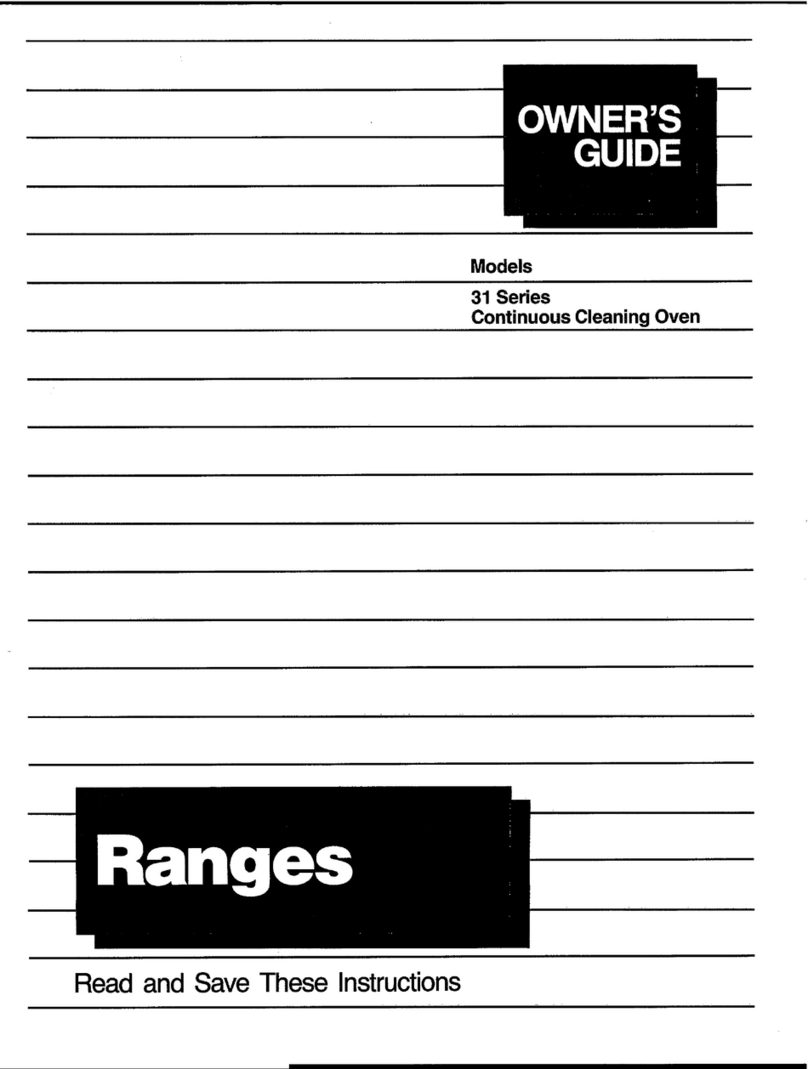
Tappan
Tappan 31 series User manual
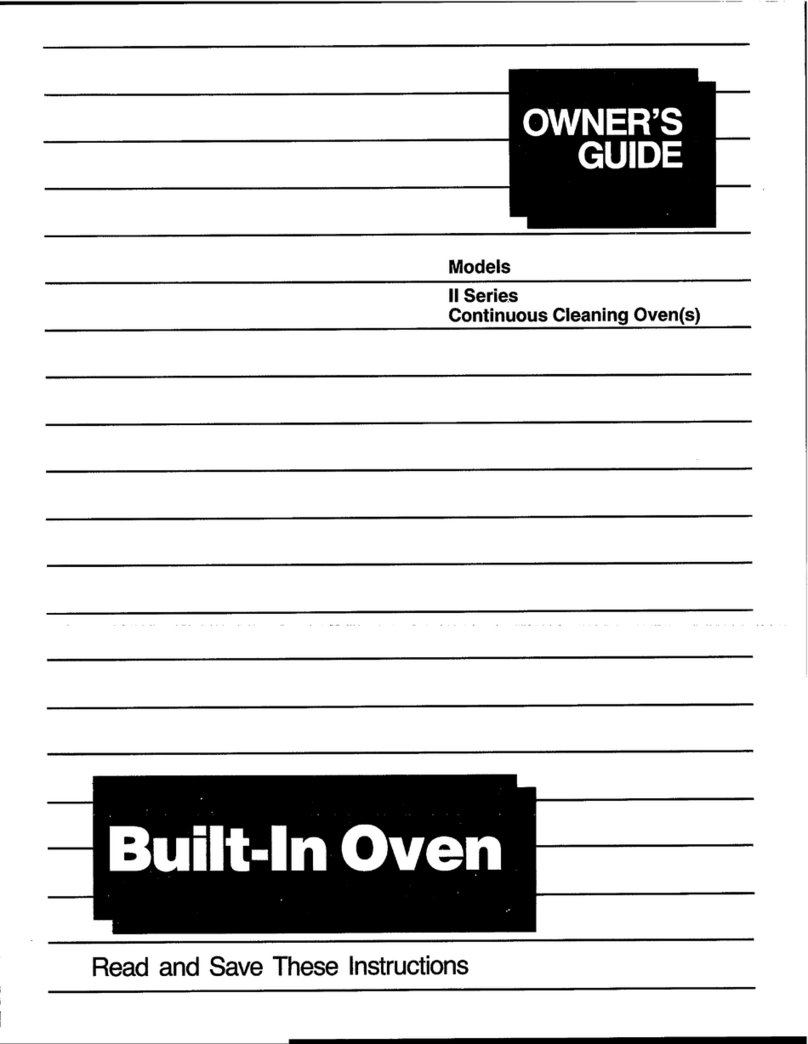
Tappan
Tappan II Series User manual
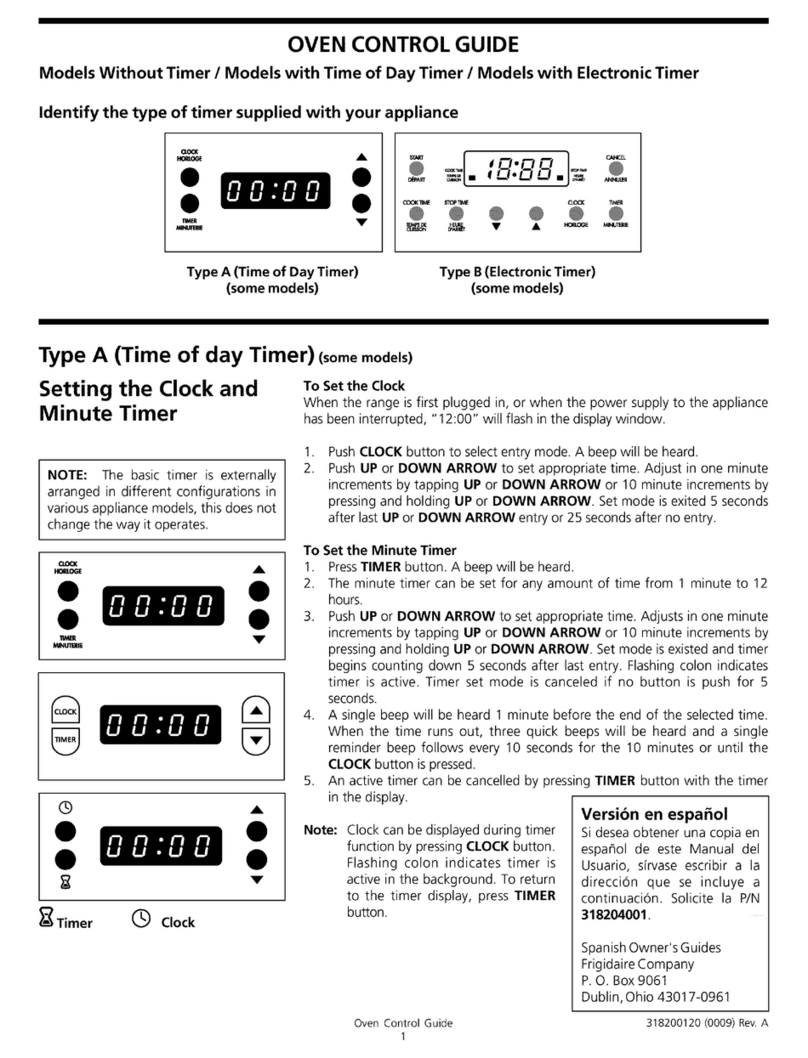
Tappan
Tappan TGF645WFD7 Use and maintenance manual
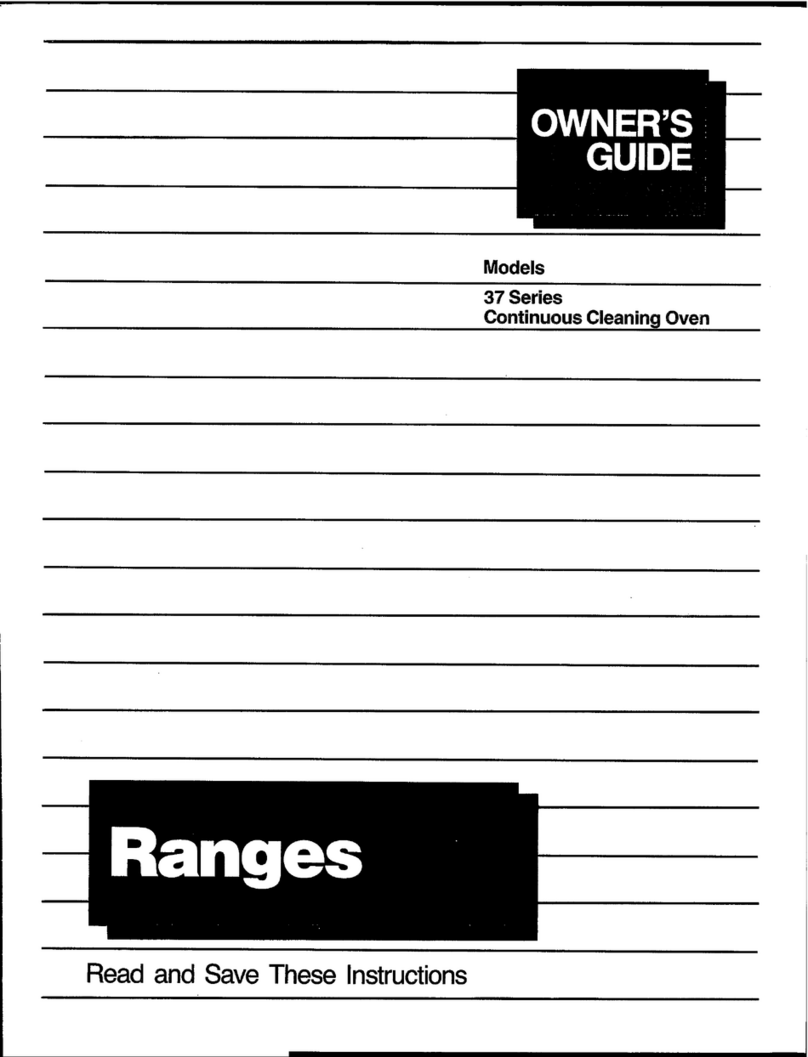
Tappan
Tappan 37 series User manual
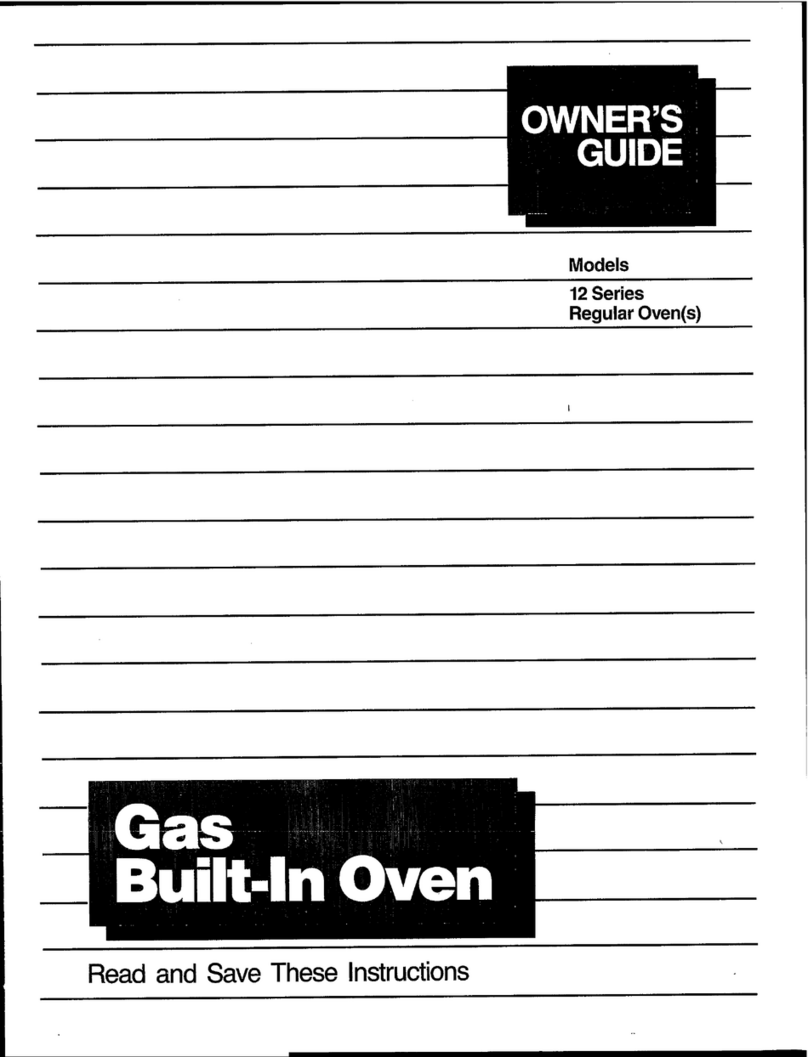
Tappan
Tappan 12 series User manual

Tappan
Tappan 31 series User manual
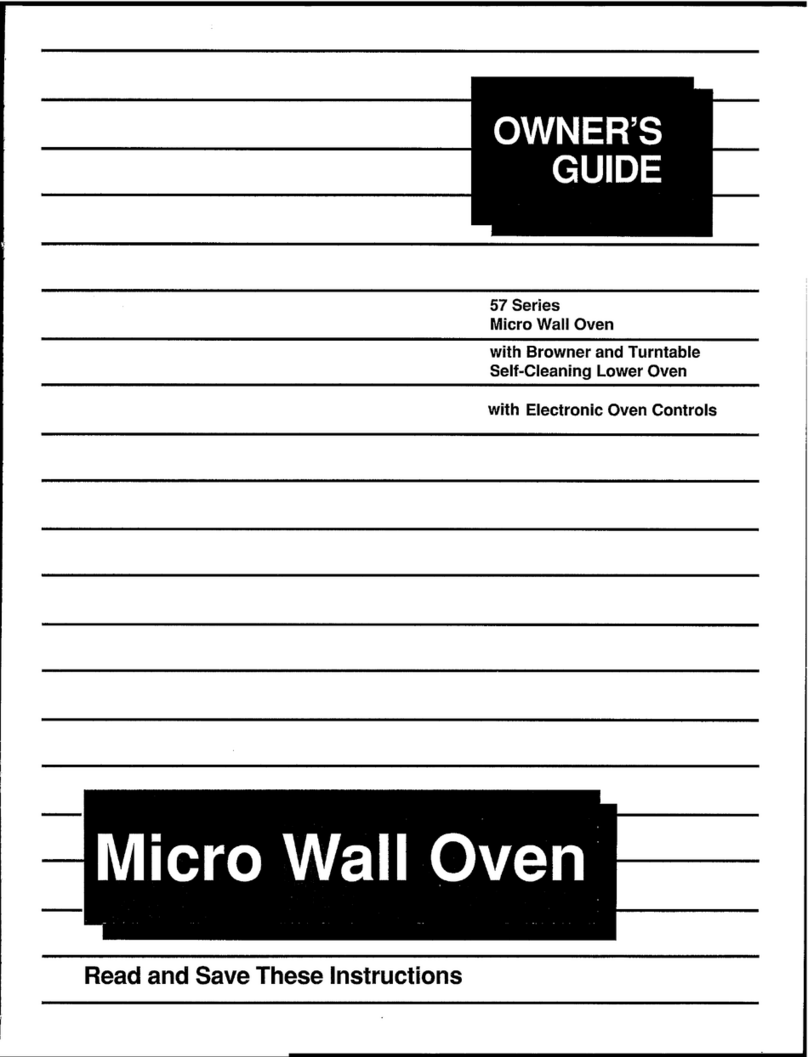
Tappan
Tappan 57 series User manual

Tappan
Tappan 37 series User manual
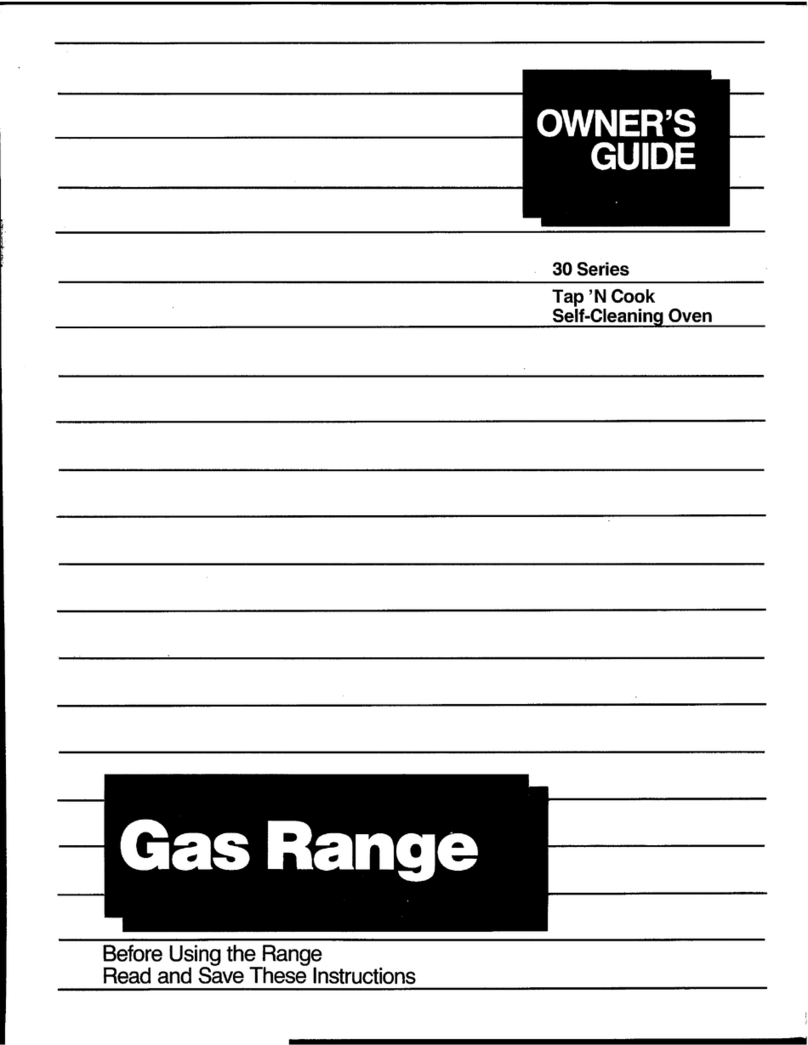
Tappan
Tappan 30 series User manual

Tappan
Tappan Z12-1249 Manual
Popular Oven manuals by other brands
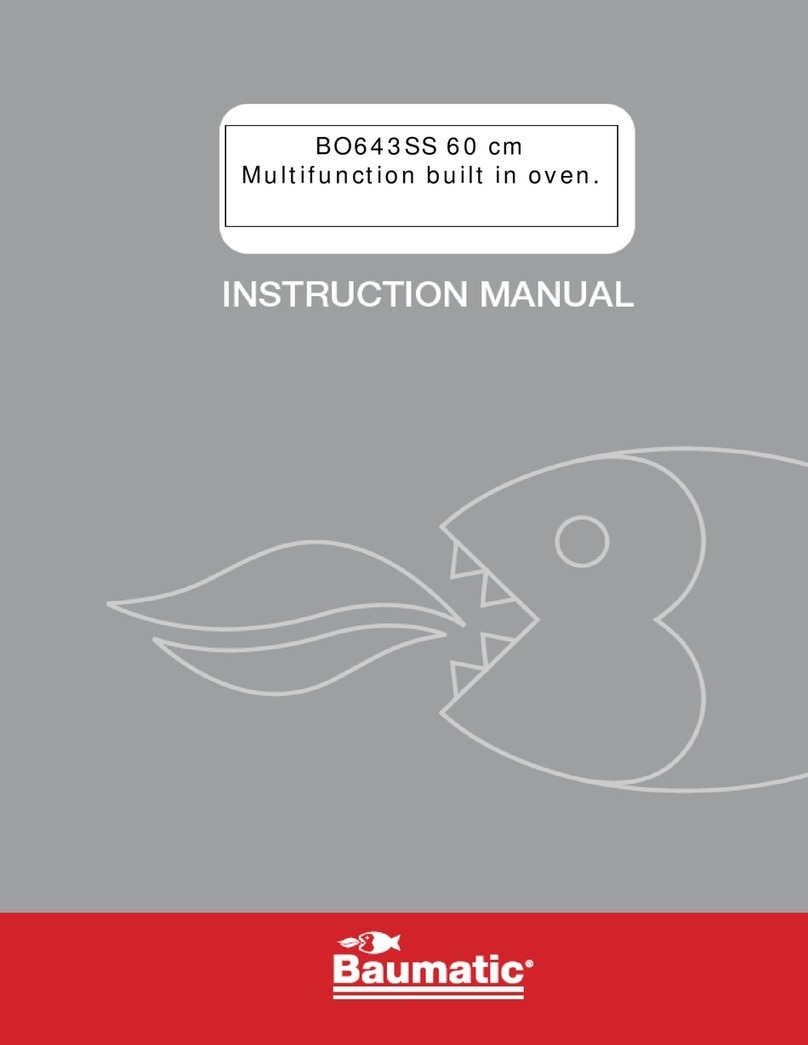
Baumatic
Baumatic BO643SS instruction manual

Miele
Miele H6361BP Operating and installation instructions

Thermador
Thermador MES301HS Quick reference guide

Le Panyol
Le Panyol LIBERTE Series Assembly instructions
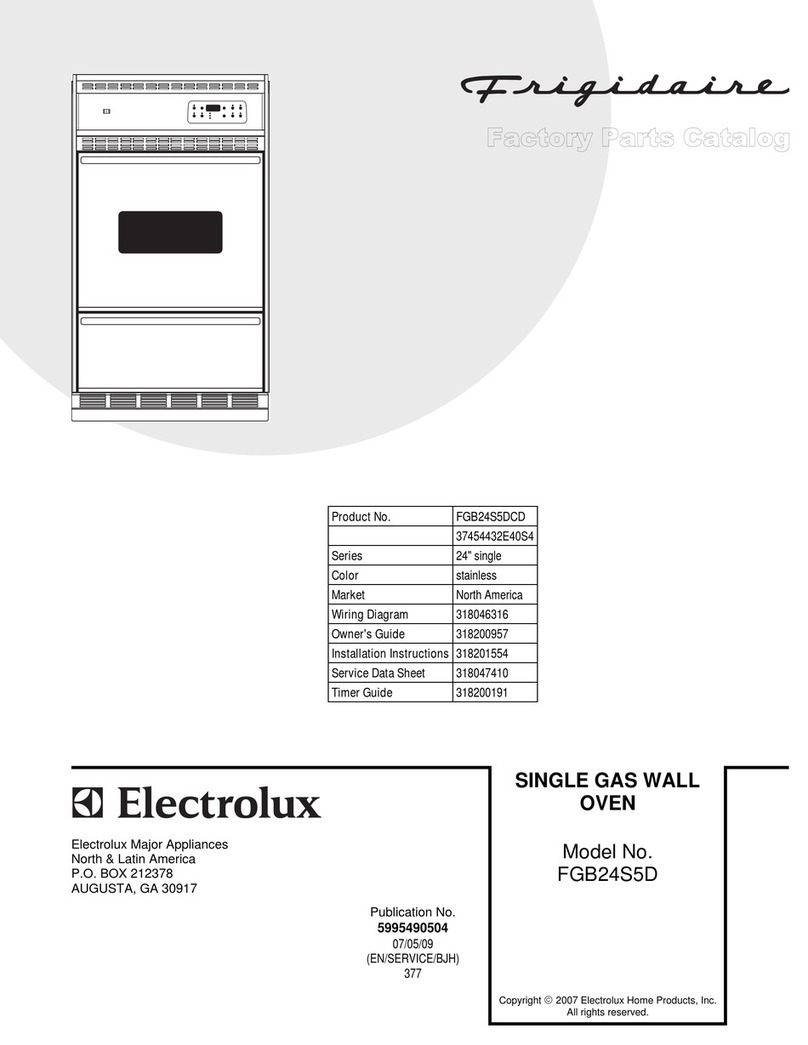
Frigidaire
Frigidaire FGB24S5D C Factory parts catalog

Furnotel
Furnotel FDA-106 Operating and maintenance instructions
